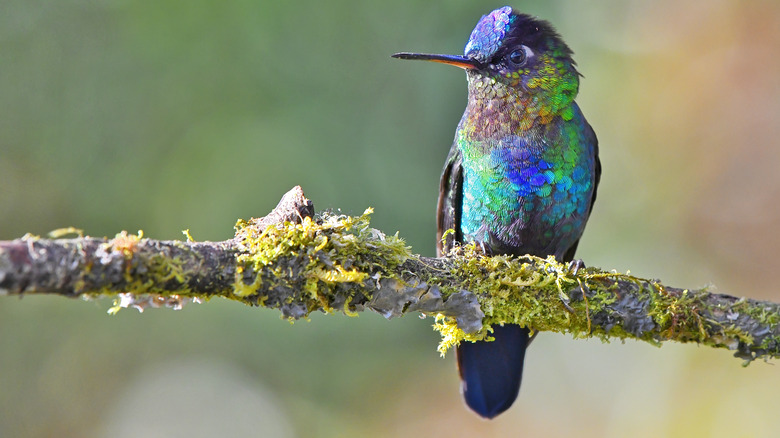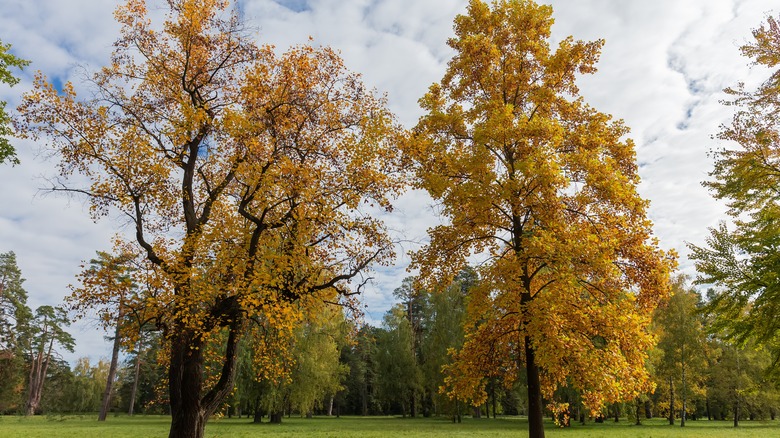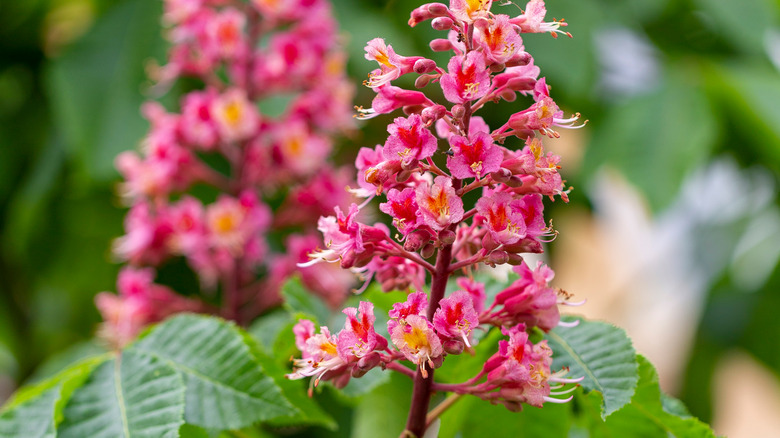Plant This Gorgeous Tree And Watch Hummingbirds Flock To Your Yard
If you think that no single tree can offer the impeccable combination of low-maintenance, high shade, and sheer radiance that draws the attention of gardeners and hummingbirds alike, we've got news for you! Crowned as state trees in Indiana, Kentucky, and Tennessee, tulip trees (Liriodendron tulipifera) are gorgeous native specimens that can add a pop of color to your yard with their limey yellow inflorescence. While you might have a hard time appreciating their fragrant blooms since they populate the crowns after the foliage has matured on trees soaring 80 to 120 feet high, hummingbirds are unbothered by the elevated vantage point, meaning that this tall tree will lure them into your yard.
The six-petaled, goblet-shaped, tulip-like flowers act like calling signals to hummers who find their orange-banded, buttery yellow tones (acutely apparent in fall) especially attractive. Once enticed, the hummingbirds keep coming back annually for the nectar. Unsurprisingly, the sweet sap has a host of other admirers, such as bees, cedar waxwings, spicebush swallowtails, and eastern tiger swallowtails. Squirrels, rabbits, and deer are no strangers to the allure of their buds and seeds either, highlighting the tulip tree's ability to assemble an array of biodiversity within its 30- to 60-foot spread.
Optimal growing conditions for tulip trees
At home in the United States' southeastern woods, tulip trees (or poplars) are hardy in USDA zones 4 to 9, except in particularly dry, arid regions. They prefer organically rich, slightly acidic, well-draining soils, but high salt content is a deal-breaker. Since they root shallowly, they're susceptible to drought stress, but supplemental irrigation should help. Full sun is a must if they're 'in the wild,' however, they may put up with some shade in the home garden and assume a pyramidal shape, eventually turning ovate at maturity. However, this won't mean much to hummingbirds, as they will happily establish their cup-shaped roosting and nesting sites so long as the tree is sufficiently tall and shelters them from roving eyes.
While tulip trees attract a swarm of pests like aphids and scales, hummingbirds can save you some headache and labor by picking these insects off whole (no dead-body cleanup, yay!) — after all, all that humming requires ample energy. This might also aid the tree in staving off mold and mildew that develops courtesy of aphids' honeyed secretions. But you must remain alert for diseases like canker and verticillium wilt, especially if you're a tardy caregiver. Remember, tulip trees' fast growth keeps their lumber weak, so avoid planting them if your yard faces strong gales or heavy snow.
Plant tulip trees with their hummer-attracting companions
To give the tulip poplars their best shot at success, plant their balled and burlapped rootstock as soon as spring ushers in. But if you've missed the window, transplant tulip trees from nursery containers instead. This can be done anytime around the year, especially in southern states. Since tulip trees grow quite tall, small yard owners should consider planting dwarf varieties like Compactum and Ardis (matures at 15 feet). Or, grow their variegated, slow-growing breeds, like the Aureomarginatum, and prune them down to a shrub every two to three years. As a bonus, you won't have to crane your neck too much just to behold hummers in action.
Further, indulge in companion planting to create a thriving hummingbird haven. For instance, instead of planting rows of tulip poplars, mix in trees like red buckeye (Aesculus pavia), especially in partially shaded areas. Their tubular, burgundy-red blooms are just right for the hummers to dip their beaks into. If you're looking for understory planting, your choices might be limited, as tulip trees grow poorly branched, shallow roots. That being said, Florida Azalea (Rhododendron Austrinum) is a shade-friendly option for southern states. Its bronze-yellow racemes complement the yellow poplars and work in a layered arrangement since they mature to around 10 feet in height. Early-blooming, evergreen shrubs like mountain laurel are alternatives that pull in hummingbirds and pollinators with their showy pink or lavender flowers. However, keep snooping pets out since they're all poisonous if consumed.


